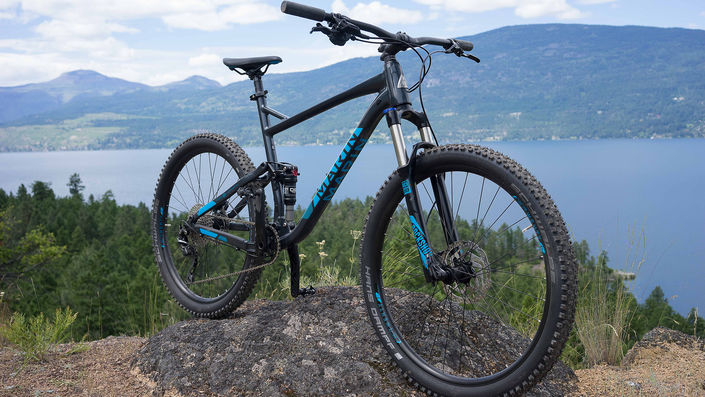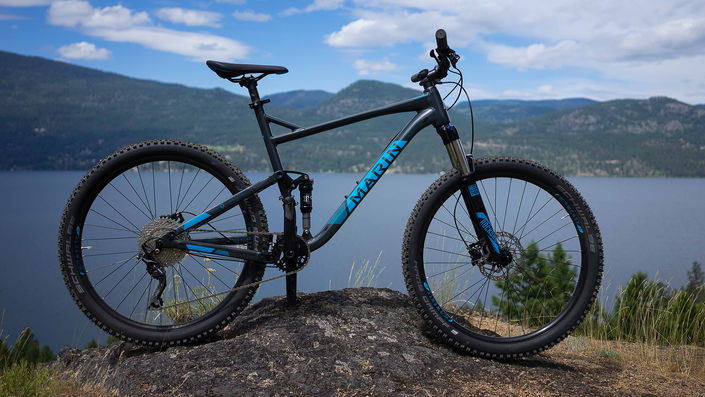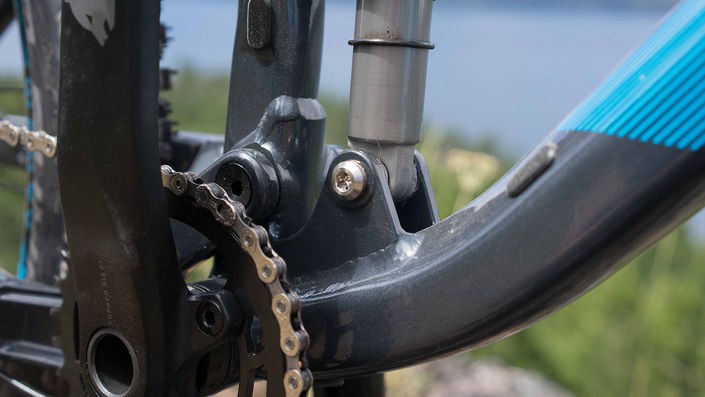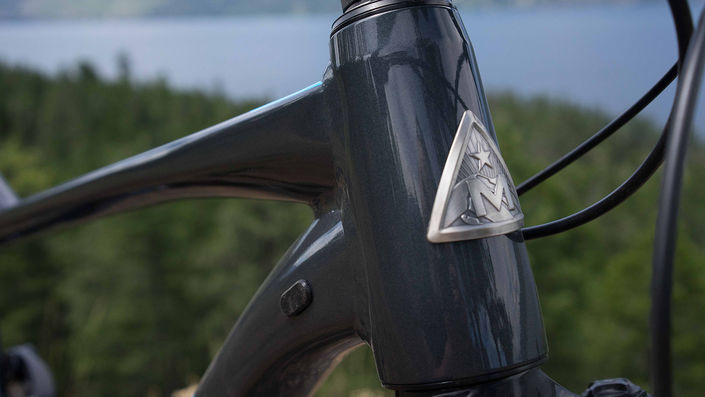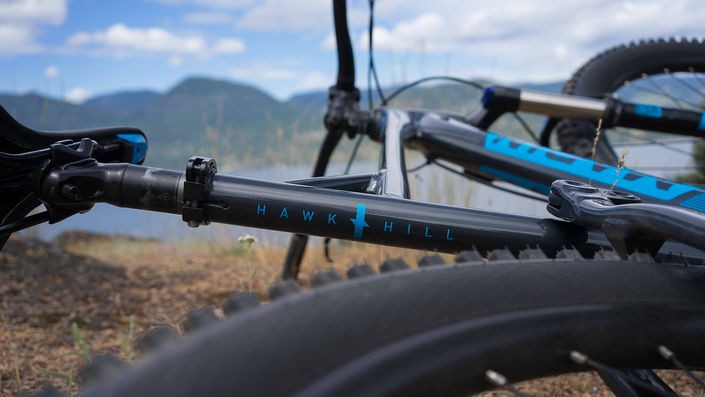When Marin first released images and specs of the new Hawk Hill, with its hydroformed aluminum tubing, air-sprung suspension, internal cable routing, and up-to-date build kit, the market was extremely interested to see the price. With the Hawk Hill coming in at $1499 USD, Marin may have hit the nail on the head for entry level trail bike consumers.
RELATED: Bro, do you really need XTR?
Marin makes it clear it is possible to offer a bike that can handle almost all trail riding for a reasonable price. Friendlier pricing on entry-level bikes may help attract new riders, whereas the sticker shock of top-tier carbon rides can scare riders from the sport. The hydroformed frame looks clean and decent — it’s obvious that it’s no top-shelf race winner, but that should be common sense — and the air suspension means this bike can be sprung for almost any level of rider.
Specifications:
- Frame: Series 3 6061 aluminum frame
- Front fork: RockShox Recon Silver RL 27.5
- Crankset: Marin Forged Alloy 1x10, hollow spindle, steel narrow-wide 32T chainring, 76mm BCD
- Rear derailleur: Shimano Deore Shadow Plus Direct Mount
- Shift lever: Shimano Deore 1x10-speed
- Cassette: SunRace 10-speed, 11-42T
- Bottom bracket: External sealed cartridge bearings
- Rear Shock: X-Fusion O2 Pro R, 190mm x 50mm, Tube-B
- Chain: KMC X10
- Rims: Marin, double-wall alloy, 27mm inner, tubeless compatible
- Brakes: Shimano BR-M315 hydraulic disc, 180mm rotor
- Bar: Marin Mini-Riser, 6061 double-butted aluminum
- Stem: Marin 3D forged alloy
- Headset: FSA Orbit, sealed cartridge bearings
- Seatpost: Marin, two-bolt alloy
- Saddle: Marin Speed Concept
Marin Hawk Hill at first look:
Coming in at 31.11 lbs / 14.37 kgs (size XL), and with 120 mm of rear travel, the Hawk Hill doesn’t seem far off from a bike with twice the price tag. The 6061-aluminum frame has a modest 67.5-degree head tube angle and a 69.5-degree seat tube angle, making it appropriate for typical trail riding. When you look at the frame specs, the Hawk Hill is fairly standard for most bikes in its class; where it stands out is in the build kit and some of the frame features.
Marin spec's the Hawk Hill with a blended componentry package, which includes some house branded stuff and Shimano, SRAM, and X-Fusion, to give you the best bang for your buck. The 1x10 Shimano Deore drivetrain is a nice addition, as the Shadow derailleur does a good job of shifting the chain across the SunRace 10 speed 11-42t cassette. The Marin-branded crankset is burley enough for most riders, and the narrow-wide chainring completes the drivetrain package. The brakes are the steadfast Shimano Deore, shifters are Deore, and the 780mm bar and 60mm stem combo are Marin house-branded. If you aren’t getting the picture, the build kit on this $1499 rig is fairly modern and competitive, but where things get really interesting are in the wheels, suspension, and final frame details.
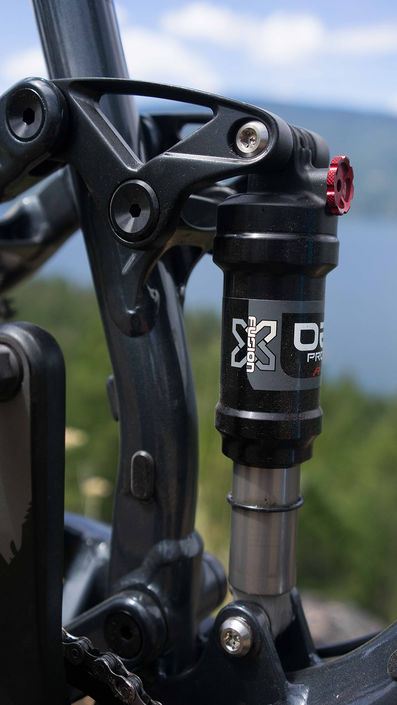
photo: Josh Palmer | BikeRoar
The Marin house-branded wheels feature rims with an inner width of 27 mm, making them quite wide and aggressive compared to what most bikes of this price point spec. The Schwalbe Hans Dampf 2.3 tires take full advantage of the wider rims and give the rider a more stable platform than expected for an entry level bike. The rear axle is a standard 135mm QR, but remove the dropout inserts and the Hawk Hill can handle an upgraded 142 mm x 12 mm thru axle.
Brake cable routing is external, but the routing for the rear derailleur cable is internal. There is a port for internal dropper post cable routing as well. The Hawk Hill does not come with a dropper post, but the 30.9 mm seat tube and stealth routing make it an easy upgrade. A couple other finishing touches to the frame are tapered head tube and downtube and water bottle mounts, giving the Hawk Hill almost everything you need in a frame.
Marin does an excellent job of using proper air suspension to support the Hawk Hill with a RockShox Recon Silver RL 27.5 fork and a X-Fusion O2 Pro R rear shock. Having proper air suspension means the rider has better control over the ride of their bike with little effort. You can run the appropriate air pressure to match your weight and riding style in a more ‘set it and forget it’ manner. There is rebound and compression control for the fork and rear shock which helps you customize on both ends of the stroke.
Geometry - sizes XS S M L XL:
- Stack: 574 578.6 583.2 587.8 592.4
- Reach: 400 418 437.2 450.9 464.5
- Crank Length (mm):170 170 175 175 175
- Top Tube Actual (mm): 529.95 545.02 565.27 585.23 609.1
- Head Tube Angle: 67.5 67.5 67.5 67.5 67.5
- Stem Length (mm): 60 60 60 60 60
- Head Tube Length (mm): 110 115 120 125 130
- Top Tube Effective (mm): 562.9 586.7 610 630 640
- BB Height: 337 337 337 337 337
- BB Drop: 18 18 18 18 18
The Ride:
The first thing you want to do with any new bike is make sure it’s set up properly for your weight and riding style. If you’re not confident in doing this, get your local bike shop to run through the proper setup with you. Reading the setup guide, X-Fusion recommends you run 80% of your weight in pressure, which is a good starting point. You can always add or remove PSI as you need to. It’s good to first set the PSI to the recommended level, then hit some corners and bomb some hills so you can see how it reacts, and then adjust as you like.
RELATED: Setting up mountain bike suspension
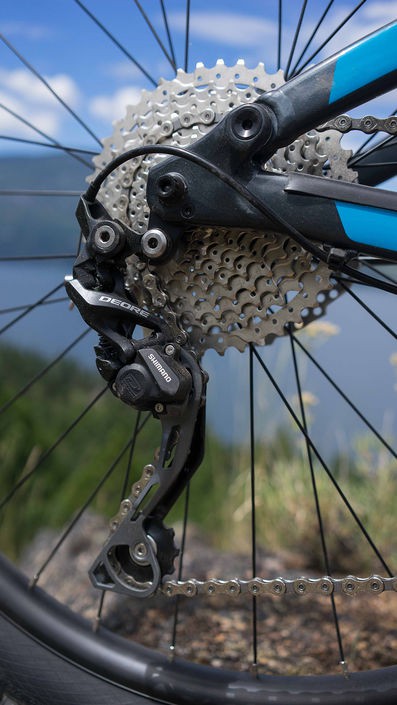
photo: Josh Palmer | BikeRoar
With both the X-Fusion shock and the RockShox fork, you can adjust the rebound and low-speed compression to suit your needs. I ran the setup quite stiff as I am 210 lbs and am used to riding bikes wide open and fast.
Out of the gate, the Hawk Hill felt quite natural under me. The frame geometry was comfortable and normal for a 120mm travel trail bike and the suspension did a decent job of pedaling under load. The drivetrain worked without issue for my rides, as Deore should. The 11-42 tooth cassette seemed well suited to most trail riding; however, it may be a little out-gunned on steep climbs. The 1x10 drivetrain will almost certainly be upgraded to a 1x11 system for the next year. If not, than an affordable SRAM NX drivetrain swap is a smart move.
The Hawk Hill is meant to bridge the gap between recreational riding and someone's first real, serious MTB, and at times it shows. The seat tube angle and the stem are parts of the bike that reflect its recreational roots, as both seemed to be a little mismatched for the more aggressive build of the bike. The steeper seat tube angle leads to a floating front-end while climbing, and the longer stem can lead to a slight delay in reaction time while cornering, and as well can put you a little too far over your front hub while descending. Seasoned riders will know how to compensate for this with their body position; however, the newer rider, for whom the bike is intended, will be left hanging.
The 67.5-degree head tube angle may be a little steep for those looking to aggressively ride this bike. I expect this to be tweaked slightly in the future. The weight of the bike was no issue, as it comes in at just over 31 lbs; not an ultralight bike by any means, but a respectable weight considering its price and performance level.
The bars were nice and wide, giving a rider the ability to cut them back if needed; however, they did feel a little odd considering they are 780mm wide and the stem is 60mm long. I would switch out the stem for something sub-50mm.
The 2.35 Hans Dampf tires and wider Marin rims did a fantastic job of giving a solid trail connection, allowing the 27.5 wheels to roll smoothly over most rocks and roots. The wheels play a big part in supporting the RockShox Recon fork, as they take a lot of the high-speed chatter out of the ride.
I found the Shimano Deore brakes needed a little tweaking. The Deore brakes come with entry-level rotors and pads, which do not do the brake proper justice, as the braking power was significantly reduced. For heavier, more aggressive riders, it’s worth swapping the rotors and pads right away.
RELATED: Don't give up on your mountain bike!
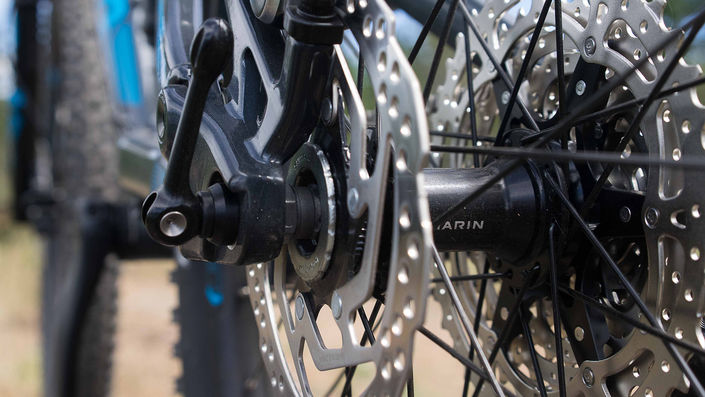
The suspension did a decent job of keeping the bike planted for most of the ride, with the exception of high speed corners, rock gardens, and drops, where the lack of high-speed compression and rebound is quite noticeable. The air-sprung Hawk Hill can get a little ‘divey’ when riding at a faster pace, where your weight and momentum can overwhelm the entry-level suspension. This means you will find your front-end diving down in corners and not recovering quickly for whatever’s coming up next. This however, is understandable when you consider the price of the bike.
Any bike sub-$2K is going to have entry-level suspension with limited controls. For most usage, the suspension worked quite well. When I would ride the green and blue level trails, the air-supported bike performed better than expected, making it a solid buy for any novice to intermediate rider. The Hawk Hill does come with a tapered head tube in anticipation that a more legitimate fork upgrade is on the horizon for most of those who purchase the bike.
All-in-all, the Hawk Hill surpassed my expectations for its ride quality and capabilities. Its' extremely neutral riding disposition means you, the rider, can choose which way you want to go with your riding, and the price makes it an easy sell on the bike shop floor.
Is the Hawk Hill worth purchasing?
Yes. What you get from Marin in the Hawk Hill is exceptional value with some good forethought into how the bike will need to change to match your skills as a rider. With internal dropper post routing, tapered head tube, 1X drivetrain, and expandable rear axle sizes, the Hawk Hill allows a rider to upgrade its components when they reach that next level of riding.
When I worked sales, I would often steer people towards used bikes when they first had an interest in riding but weren’t too sure if it was something they would really get into. With a $1499 USD price tag, the Hawk Hill is a safe bet for anyone who is thinking they may want to start riding MTB. It will allow you to grow as a rider without costing you an arm and a leg up front. No, it’s not perfect, but I dare you to find a more modern bike with the potential for upgrades anywhere close to the MSRP of the Hawk Hill.
The Hawk Hill has been an obvious success — Marin has just released 2018 models in three trim levels and a 24-26" youth version. The bike is more or less unchanged, other than a varying build kit, which includes Boost spacing, upgraded RockShox suspension, and 1x11 drivetrains from both SRAM NX and Shimano LX. The original (and now base) Hawk Hill remains a value-packed $1499 USD, while the Hawk Hill 2 and Hawk Hill 3 will set you back $1949 and $2649. Hawk Hill Jr., "just as capable as its full size counterpart," is $1499 USD.
![]() Check out the Comparison
Check out the Comparison
We should all be rejoicing as the industry is in desperate need of affordable, yet relevant, bikes like the Marin Hawk Hill. I've no doubt we'll see a slew of new Marin dealers pop-up across the globe dispensing the Hawk Hill line of bikes and many riders on the trails enjoying them.
Enter to win a
Marin Hawk Hill
Full-Suspension Trail Mountain Bike
valued at $1500 USD!
Click Here to Enter to win!
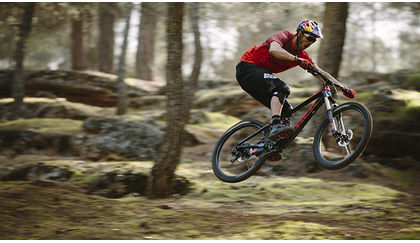
RELATED ARTICLE:
Why an all mountain bike should be your next purchase
Modern all mountain bikes have been making the most out of the newest technology; adjustable geometry, wheel size options, and frame materials are allowing all AM bike to truly be... READ MORE

RELATED ARTICLE:
Mountain bike skills: Choosing a line, handling gravel and drop-offs
BikeRoar is here to give you some tips on how you can master all the skills you will need READ MORE
